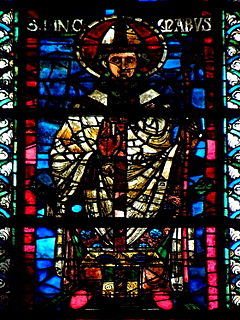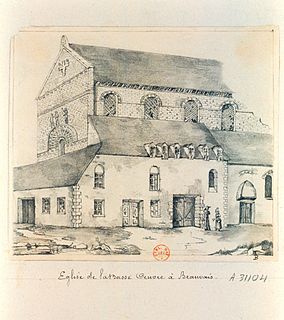For the legendary Mercian martyr, see
Wulfhad.
Wulfad (died 876) was the archbishop of Bourges from 866 until his death. Prior to that, he was the abbot of Montier-en-Der (from 856) and Soissons (from 858). He also served as a tutor to Carloman, a younger son of King Charles the Bald. Carloman succeeded Wulfad as abbot of Soissons in 860.
Wulfad was ordained a priest by Archbishop Ebbo of Reims, who had been deposed in 835 and re-instated in 840. Wulfad was ordained during Ebbo's second incumbency, which ended in 841. He may have served the anti-king Pippin II of Aquitaine, an opponent of Charles the Bald, as a notary during 847–48, a period in which support for Pippin reached a high. In 857, Charles tried to promote him to the vacant see of Langres, but was successfully blocked by Ebbo's successor, Hincmar. In 859, Wulfad was removed from his priestly office, along with all the other priests, deacons and subdeacons ordained by Ebbo, at the synod of Savonnières, held under Hincmar's presidency.
Neither Wulfad's support for Pippin nor his defrocking by Hincmar deterred Charles the Bald from appointing him archbishop of Bourges in 866. He had probably supported the king during the Neustrian rebellions of 858–60, for in a charter of 859 Charles calls him "our dearest abbot and minister". Although Hincmar disputed Wulfad's eligibility for the episcopate, the synod held at Soissons in August 866 refused to adjudicate the case. In 868 Charles convinced Pope Nicholas I that Wulfad's "prudence and vigour" were needed to counter the Vikings that threatened the region around Bourges. The pope confirmed him in the see.
In Wulfad's day, all books were copied by hand, thus friends lent books to friends to allow them to copy them out for their own libraries. A list of books in Wulfad's library, probably intended to circulate among his friends, has survived on the back of a manuscript copy of the philosopher John Scotus Eriugena's Ambigua. Wulfad was a close associate of Eriugena, who dedicated to him his Periphyseon and called him a "collaborator in philosophical disputes". Wulfad's list of books includes titles by Eriugena, including the latter's translations of Pseudo-Dionysius and Maximus the Confessor's Ad Thalassium. There is a poem preserved in the manuscript F. 67 in the Leiden Universiteitsbibliothek that preserves a poem addressed to Wulfad by a monk suffering from the cold while his fellow monk, Wulfad's former student, Carloman, was by a warm fire. [12]
Year 877 (DCCCLXXVII) was a common year starting on Tuesday of the Julian calendar.

Charles the Bald was a 9th-century king of West Francia (843–877), king of Italy (875–877) and emperor of the Carolingian Empire (875–877). After a series of civil wars during the reign of his father, Louis the Pious, Charles succeeded, by the Treaty of Verdun (843), in acquiring the western third of the Carolingian Empire. He was a grandson of Charlemagne and the youngest son of Louis the Pious by his second wife, Judith.

Hincmar, archbishop of Reims, was a Frankish jurist and theologian, as well as the friend, advisor and propagandist of Charles the Bald. He belonged to a noble family of northern Francia.
Gottschalkof Orbais was a Saxon theologian, monk and poet who is best known for being an early advocate of the doctrine of two-fold predestination. From his friend Walahfrid Strabo, Gottschalk also received the nickname Fulgentius, after Fulgentius the Mythographer, whom he may have studied intensively.

Ermentrude of Orléans was Queen of the Franks by her marriage to Charles the Bald, Holy Roman Emperor and King of West Francia. She was the daughter of Odo I, Count of Orléans and his wife, Engeltrude de Fézensac.

Tilpin, Latin Tilpinus, also called Tulpin, a name later corrupted as Turpin, was the bishop of Reims from about 748 until his death. He was for many years regarded as the author of the legendary Historia Caroli Magni, which is thus also known as the "Pseudo-Turpin Chronicle". He appears as one of the Twelve Peers of France in a number of the chansons de geste, the most important of which is The Song of Roland. His portrayal in the chansons, often as a warrior-bishop, is completely fictitious.

Ebbo or Ebo was archbishop of Rheims from 816 until 835 and again from 840 to 841. He was born a German serf on the royal demesne of Charlemagne. He was educated at his court and became the librarian and councillor of Louis the Pious, king of Aquitaine, son of Charlemagne. When Louis became emperor, he appointed Ebbo to the see of Rheims, then vacant after the death of Wulfaire.
Carloman was the youngest son of Charles the Bald, king of West Francia, and his first wife, Ermentrude. He was intended for an ecclesiastical career from an early age, but in 870 rebelled against his father and tried to claim a part of the kingdom as an inheritance.

Rodulf was the archbishop of Bourges from 840 until his death. He is remembered as a skillful diplomat and a proponent of ecclesiastical reform. As a saint, his feast has been celebrated on 21 June.
Frothar or Frotar was an Aquitanian prelate in West Francia, who held two different bishoprics and three abbacies during a long career. He was appointed Archbishop of Bordeaux around 859, but Viking raids forced him to abandon his seat in 870. With papal approval, he was transferred to the archdiocese of Bourges in 876. He died after 893.

The Roman Catholic Diocese of Soissons, Laon, and Saint-Quentin is a diocese of the Latin Rite of the Roman Catholic Church in France. The diocese is suffragan to the Archdiocese of Reims and corresponds, with the exception of two hamlets, to the entire Department of Aisne. The current bishop is Renauld Marie François Dupont de Dinechin, appointed on 30 October 2015. In the Diocese of Soissons there is one priest for every 4,648 Catholics.
Hincmar, called the Younger, was the Bishop of Laon in the West Frankish Kingdom of Charles the Bald from 858 to 871. His career is remembered by a succession of quarrels with his monarch and his uncle, archbishop Hincmar of Rheims. After initial loyalty to Charles trouble occurred from 868 due to the allocation of benefices on the see's estates. The conflict grew dangerous as it became embroiled in the larger dispute of Lotharingian succession following Lothair II’s attempted divorce from his wife. Hincmar’s struggle against his king provides a Carolingian example of early Medieval clerical exemption.

Louis II, known as Louis the Stammerer, was the king of Aquitaine and later the king of West Francia. He was the eldest son of Emperor Charles the Bald and Ermentrude of Orléans. Louis the Stammerer was physically weak and outlived his father by a year and a half.
Wenilo was the archbishop of Rouen from 858. He was an appointee of King Charles the Bald.
Wenilo was the archbishop of Sens from 836 or 837. Prior to becoming bishop, Wenilo was a palatine chaplain. As bishop, he was one of the leading men in Aquitaine and crowned Charles the Bald king in 848, definitively uniting Aquitaine with West Francia. In 858, he supported the East Frankish invasion and was denounced as a traitor by the king. He reconciled the next year, and retained his office until his death. Nevertheless, Wenilo passed into legend as Ganelon, the archvillain of the Matter of France, his name a byword for "traitor".
Ragenar was the bishop of Amiens from 830 to 833 and again from 834 until his death in 849. His predecessor, Jesse, was initially deposed by the Emperor Louis the Pious in 830 for conspiring with his rebellious son Lothair. In 833 he was restored when Lothair forced his father to make public obeisance at an assembly in Soissons. When Louis regained his position in 834, Jesse was again deposed and this time exiled to Italy, where he died in 836.

Odo I was a West Frankish prelate who served as abbot of Corbie in the 850s and as bishop of Beauvais from around 860 until his death in 881. He was a courtier and a diplomat, going on missions to East Francia and the Holy See.
Guntbold was the archbishop of Rouen from 836 until his death in 849.
There have been several Catholic Church synods called the Council of Soissons:
Wilchar was the archbishop of the province of the Gauls, succeeding Chrodegang after 766 as the leading bishop in the kingdom of the Franks. Before receiving the pallium, he ruled a suburbicarian diocese in Rome. As archbishop, he held the diocese of Sens for a time (762/769–772/778) and afterwards held authority over all Gaul without a fixed see.








